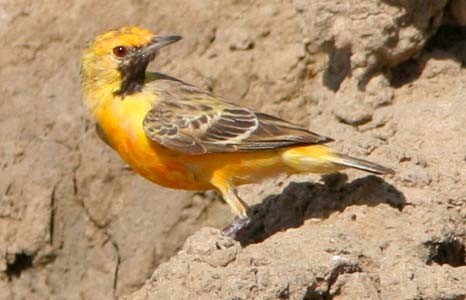Orange Chat
A species of Australian chats Scientific name : Epthianura aurifrons Genus : Australian chats
Orange Chat, A species of Australian chats
Botanical name: Epthianura aurifrons
Genus: Australian chats
Content
Description General Info
 Photo By Don Roberson
Photo By Don Roberson Description
The orange chat (Epthianura aurifrons) is endemic to Australia. Orange chats are usually 10–12 cm (3.9–4.7 in) in length, 10–12 g (0.35–0.42 oz) in weight and have an average wingspan of 19 cm (7.5 in). The orange chat is a small ground songbird with relatively long, broad and rounded wings and a short square-ended tail. The orange chat is potbellied in shape with long thin legs, a short slender straight bill and a brush-tipped tongue. Male feathers are mostly a deep, warm, cadmium yellow with orange overtone, and this colour is strongest on the crown and breast. Males' lores and throat are black, their rump is a golden orange with a tail finely tipped with white. Female chats are mottled in grey-brown with underparts being a softer fawny yellow. Orange chats do not have any seasonal differences in plumage. 
Size
12 cm
Nest Placement
Ground
Feeding Habits
Orange Chat mainly feast on ground-dwelling invertebrates, including ants, bees, wasps, beetles, caterpillars, grasshoppers, and spiders. Occasionally, they forage alongside other bird species and may consume seeds, showing adaptability in their diet. Unique foraging behavior includes walking, mostly near the ground or water's edge, rather than hopping.
Habitat
The habitat of orange Chat predominantly encompasses open chenopod shrublands and stony terrain within arid to semi-arid zones, often found near samphire vegetation surrounding saltlake peripheries. They are known to inhabit low Acacia woodlands or dense shrublands with flora like Eremophila and Grevillea. Occasionally, orange Chat can be seen in grasslands, including spinifex, but infrequently in agricultural areas.
Dite type
Granivorous
General Info
Feeding Habits
Bird food type
Behavior
The orange chat is gregarious and mobile with undulating flight, but they are also very wary, which does not allow close interactions. They are easy to see from a distance perched atop low bushes, shrubs or trees, due to the vivid orange plumage of the male. Males will often keep watch from a tall shrub or bush whilst the rest of the flock feeds out of sight. Foraging occurs on the ground or from low shrubs. Orange chats are usually seen in pairs or small groups of up to 15 birds, although flocks of more than 400 have been recorded locally. They are often spotted mixing with flocks of crimson and white-fronted chats and seen near or with flocks of zebra finches. When flushed, the orange chat will fly high, briefly perching atop a low shrub before disappearing onto the ground and between shrub cover. At the start of the breeding season flocks disperse into pairs. After the pair has formed, the male accompanies the female at all times until the eggs have been laid and chases other birds, often other males, that approach the pair; this behaviour is rarely seen outside the breeding season. Defensive behaviour Defence of territory is mainly performed by males when breeding; females usually only become involved when the male is absent. Distraction displays From incubation to just after fledging, one or both adults feign injury, flapping along the ground. Sometimes they will not return to their nest while the observer/predator is present. 
Distribution Area
Orange chats are strongly nomadic within the arid and semi-arid zones of Australia that they inhabit. They are found mainly in the interior with some sightings in the northern tropics, and very occasionally they reach the coastal areas of South and Western Australia. The orange chat mostly occurs in dry, low-lying, saline environments that are rarely flooded such as sparsely vegetated gibber plains, salt pans, salt lakes, or claypans. They mainly inhabit low, treeless chenopod shrublands dominated by saltbush, bluebush or samphire, with either open or continuous shrub cover. They are sometimes recorded in other open or shrubby habitats, often near wetlands: low mulga, low buloke woodland; open acacia scrubland; dongas (steep-sided gullies) vegetated with tall shrubs or small trees including mulga, dead finish, belah or sugarwood; grassland; or sedgeland. The orange chat has occasionally been recorded in mallee woodlands and on farmlands, including areas over-run by scotch thistle. 

 Photo By Don Roberson
Photo By Don Roberson Scientific Classification
Phylum
Chordates Class
Birds Order
Perching birds Family
Honeyeaters Genus
Australian chats Species
Orange Chat